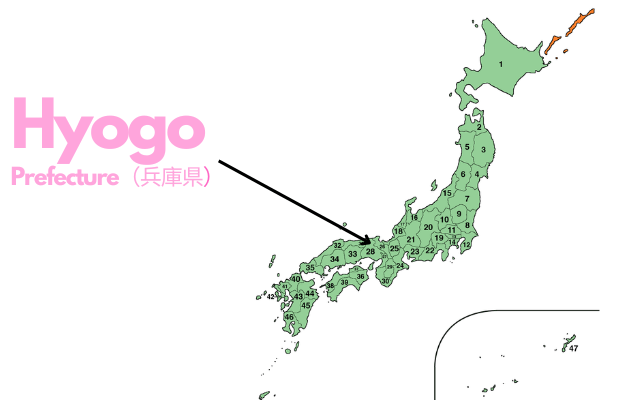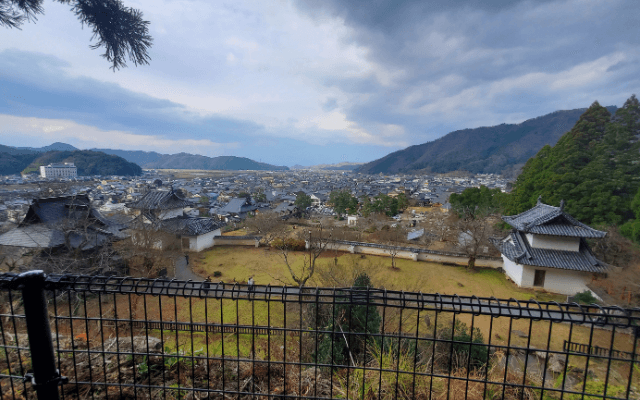Background image courtesy of Note Thanun
The Japan Exchange and Teaching (JET) Programme has become an increasingly popular way for those interested in Japan to experience its rich culture through living and working in Japan. Here is what you need to know about being an Assistant Language Teacher (ALT) while on JET and what a placement in Hyogo Prefecture has to offer.
Let’s get started!

Hello readers! Sakura Mobile is a SIM & WiFi service provider for international residents and tourists in Japan.
Our global editorial team living in Japan will introduce the charms of the country based on what we have actually experienced and felt.
Table of Contents
- What is the JET Programme?
- Benefits of the JET Programme
- What ALTs Do
- How to apply for the JET Programme
- About Hyogo
- Sights to See
- Foods to Try
- Things to Prepare Beforehand
- Things to Be Careful of
- Conclusion
What is the JET Programme?
The Japan Exchange and Teaching (JET) Programme, established in 1987, was founded with the purpose of promoting internationalization in Japan’s local communities through international exchange and foreign language education. Participating in the JET Programme means more than just teaching English, as the “Exchange” in its title will tell you – it is an opportunity for you to be a cultural ambassador, teaching local Japanese communities about your home country while learning about Japan in turn. Living in a different country can be scary, particularly if its culture and language are so different from your home. But that is precisely where the charm lies. If you want to experience a new culture to the greatest extent possible and you are willing to take the plunge, your participation in the JET Programme can be an incredibly exciting, fun, and rewarding new chapter of your life.

Photo courtesy of Mantas Hesthaven
↑ Go back to the table of contents
Benefits of the JET Programme
If you still have reservations about applying to the JET Programme, have no fear, for you won’t simply be left to fend for yourself once you arrive in Japan. The JET Programme offers many benefits and support resources, making it an attractive option for cultural exchange and learning.
No Japanese Required
If not knowing Japanese is your concern, I have some good news for you! You can apply to be an ALT on the JET Programme without knowing any Japanese. In fact, your participation can be an excellent opportunity to learn the language, as you will be encouraged to do so! By living in Japan, you will be immersed in the Japanese language, which can greatly boost your learning. By coming to Japan on JET, you will also have access to free online Japanese language courses and grants if you pass the N1, N2, or N3 levels of the JLPT (Japanese Language Proficiency Test)!
Training and Resources
If you are worried about diving into this opportunity with no cultural knowledge about Japan, do not fear! The JET Programme offers an orientation to participants covering this and more when they arrive in Japan, and many receive further training when they reach their placement destination. JET Programme participants will also receive the General Information Handbook, which covers various topics, including preparing to move to Japan, safety, situations you may encounter at work, and steps to take when you leave the JET Programme. An ALT handbook is also available, which contains information about work duties and advice that participants will find very helpful, especially if they do not have a work background in education.
Help with Moving to Japan
After you are accepted as a participant, your local Japanese embassy or consulate will help you through the often intimidating process of applying for a visa. Once in Japan, participants often get assistance from their employer, also known as their contracting organization, for various necessities for getting settled in Japan, such as opening a bank account and (if necessary) renting or buying a car. In some cases, contracting organizations can also arrange housing for participants.

↑ Go back to the table of contents
What ALTs Do
The work you do as an ALT may differ from that of other ALTs, as this depends on your contracting organization. Your employer is neither JET, the Council of Local Authorities for International Relations, nor the three Japanese government ministries that make the program possible. Most commonly, ALTs are employed by local boards of education. Though the work may vary, all ALTs have much in common with their duties.
Team Teaching
Whether you are teaching at an elementary school, junior high school, or high school, you will be expected to teach together with Japanese teachers of English. Your pronunciation will be a great example to the students as an English speaker. Because of this, you may commonly be asked to read passages in front of the class or review pronunciation. Of course, you will also be expected to introduce the culture of your home country to your students as well! Though some ALTs come to take more of a leading role in class, they will always have the support of the homeroom teacher.

Preparing Teaching Materials
While schools from the elementary to the high school levels will use a textbook, it’s important to spice things up and introduce new material from time to time! This is an area where ALTs often step in, preparing flashcards, games, and other materials and sometimes planning their own lessons.
Clubs and Extracurricular Activities
These will be much more prevalent at the junior and high school levels. Schools may have after-school English clubs that would greatly appreciate an ALT’s help, but ALTs can often participate in clubs and activities unrelated to English too! Do you play any sports? You may be able to help in your school’s club with a sport you play! Baseball, basketball, and soccer clubs are common in schools, and they will likely welcome your participation if you ask. If there is a club for a sport or activity you have never tried but have an interest in, feel free to ask if you can join! Clubs for traditional Japanese sports, such as kendo and karate, also exist! Outside of sports, schools will commonly also have band or music clubs and other cultural activities. While extracurricular activities and clubs will be an additional time commitment, they can be a great opportunity to try new things and improve relationships with your school staff and students!

↑ Go back to the table of contents
How to Apply for the JET Programme
Applying for the JET Programme is a long process that takes several months. If you are interested in applying, you will have to do so through the JET Programme website for your home country. Each participant country may have different application start dates, deadlines, and requirements, but applications are typically accepted starting in the fall. Be sure to check the information that applies to your home country.
In any case, as part of your application, you can choose three areas of Japan that you would like to live in, though it will not be guaranteed that you will be placed in one of your chosen areas. These areas can be as specific as a particular city or more general, such as requesting anywhere in the Kansai region. But if you are unsure where you would like to go, allow me to introduce you to the charm of Hyogo Prefecture!

↑ Go back to the table of contents
About Hyogo

Hyogo Prefecture (28) is in the Kansai region in western Japan. It borders Tottori (31), Okayama (33), Kyoto (26), and Osaka (27) prefectures. It faces the Sea of Japan on its north side and the Pacific Ocean on its south.
If you are placed in Hyogo Prefecture, you are in luck! There are many things to do and see, and with its location near the center of Japan, you can easily travel to some of Japan’s most popular spots. Even if you are not familiar with Hyogo Prefecture, you may have heard of Kobe beef. Hyogo Prefecture is its home, and it is a must-try! And though the big cities may be attractive, there is more to Hyogo than the bustling city centers in the south! The Tajima region in northern Hyogo Prefecture is home to Tajima beef and Kinosaki Onsen, which is 2.5 hours away from Kobe by train. Tajima Airport also serves the northern Hyogo region if you are looking to travel to the region by airplane. While you are in Hyogo prefecture, here are some must-visit spots!
↑ Go back to the table of contents
Sights to See
Kinosaki Onsen
Kinosaki Onsen is home to seven public hot spring bathhouses, all of which are tattoo-friendly! There are also many ryokan, traditional Japanese inns, which are an excellent way to experience traditional Japanese culture. Many of these ryokan will also provide free passes to access its seven public bathhouses. Day passes are also available if you will not be staying for the night.

Takeda Castle Ruins
Located in Asago, it is sometimes called “The Machu Picchu of Japan,” and it is easy to see why. Though no buildings of the castle remain, it offers a fantastic view. The best time to visit is in autumn, when, if you are willing to brave an early morning journey, it appears as though it is floating on a sea of clouds.

Himeji Castle
Himeji Castle is famed for its brilliant white color and beauty and is one of Japan’s most well-known castles. It boasts a long history and has been magnificently preserved throughout the years. If you are interested in Japanese history or simply just want to experience its beauty for yourself, this is a must-visit spot!

Izushi Castle Town
Known as the “Little Kyoto of Tajima,” the town of Izushi developed around Izushi Castle. The town makes efforts to preserve the traditional buildings, allowing visitors to take in an atmosphere of ages past. Soba noodles also have a long history here, and the town has approximately 50 soba shops! Known as Izushi Sara Soba, the noodles here are served in small portions on porcelain plates. If you can eat 20 plates, you can receive a small plaque as a souvenir!

Be sure to try Hyogo Prefecture’s other regional dishes, as well! There are many, but here are just a few highlights!
↑ Go back to the table of contents
Foods to Try
Akashiyaki
You may have heard of takoyaki, Japan’s delicious dish of fried octopus balls. The city of Akashi, famous for octopus, boasts its variation known as Akashiyaki! Compared to the takoyaki you may be familiar with, Akashiyaki is much softer in texture and uses eggs in its batter. And unlike takoyaki, it is dipped in broth! If you like takoyaki, this is a must-try twist.
Tajima/Kobe Beef
We cannot talk about Hyogo without mentioning Kobe beef, but the lesser-known Tajima beef also deserves the spotlight. In fact, the two are actually closely related, as Kobe beef is selected from Tajima cattle with a strict set of criteria. This means that all Kobe beef is Tajima beef, but not all Tajima beef is Kobe beef. So, for both, we have the Tajima region to thank! The marbling of the beef gives it a delicious sweetness that melts in your mouth. Enjoying it as a steak is an excellent way to experience its flavor. It is even possible to sit down in front of the grill and have it cooked right in front of you!

Sobameshi
If you had to choose between yakisoba and fried rice, which would you choose for your next meal? Can’t decide? Worry not, for Kobe has a solution to your problem – why not both? Cheap yet delicious, the dish combines fried rice and chopped fried soba noodles, from which it receives its name, and adds beef tendon, cabbage, and sauce to the mixture.
Another great point about Hyogo is its location – if you are placed here, you will be in a great location to take day trips to experience some of the Kansai region’s most popular spots. You can easily visit Osaka and Kyoto by train!
↑ Go back to the table of contents
Things to Prepare Beforehand
Essential Japanese Phrases
It can be easy to feel overwhelmed if you do not know any Japanese. If this is the case for you, memorizing or keeping a list of essential phrases you can fall back on is a great strategy for getting started. I highly recommend starting with these phrases.
Greetings
| Japanese | English |
|---|---|
| Ohayou gozaimasu. | Good morning. |
| Konnichiwa. | Good afternoon. |
| Konbanwa. | Good evening. |
Introductions
| Japanese | English |
|---|---|
| Hajimemashite. | Nice to meet you. |
| Watashi wa (name) desu. | I'm (name). |
| Watashi wa (place) kara kimashita. | I'm from (place). |
Other Phrases
| Japanese | English |
|---|---|
| Hai. | Yes. |
| Iie. | No. |
| Sumimasen. | Excuse me. |
| Gomen nasai. | I'm sorry. |
| Arigato gozaimasu. | Thank you. |
| Tasukete kudasai. | Please help me. |
| Eigo ga hanasemasu ka? | Can you speak English? |
| Yukkuri itte kudasai. | Please say it slowly. |
Unique Phrases
There are phrases in Japanese that are difficult to translate into English, and the following are examples of these. It is simply best to know when to use them.
| Japanese | English |
|---|---|
| Itadakimasu. | This is said before eating a meal. |
| Gochisosama deshita. | This is said after eating a meal, typically to the person who prepared it. If someone treated you to a meal at a restaurant, you can say this to them as well. |
| Yoroshiku onegaishimasu. | You will typically say this after introducing yourself. Roughly, it means “please treat me kindly”. |
| Osaki ni shitsurei shimasu. | This is said to your coworkers when you go home for the day. Roughly, it means “excuse me for leaving before you.” |
| Otsukaresama deshita. | This is said to your coworkers when they finish work for the day. Roughly, it means “you must be tired.” |
Souvenirs From Your Home Country
Having good relationships with your coworkers and supervisors is an important step to making the most of your time in Japan. An excellent way to build these relationships is by bringing them souvenirs from your home country. In Japanese work culture, there is a tradition of bringing souvenirs (omiyage) to your coworkers when you return from a trip. Typically, these are small snacks or sweets. You can make a good first impression by bringing these, and they can be an excellent conversation starter to get to know the people in your workplace! There is also a similar custom of giving a small gift to your neighbors when you first move into your house or apartment. Though you will likely not be expected to do so, giving similar souvenirs to your neighbors will make a great first impression, and it could be a great opportunity to make friends in your local community!
Look Up Your Local AJET
The Association for Japan Exchange and Teaching (AJET) is a volunteer organization of JET Programme participants. They have organized a lot of helpful information for JET participants, covering many aspects of living and working in Japan and supporting JET participants in several ways. AJET also has local chapters for each of Japan’s prefectures, so be sure to look them up and see what resources they offer!
International Driver’s Permit
Whether or not you are allowed to drive to work will depend on your contracting organization. But if you are placed in the countryside where there are not as many options for public transportation as in the city, your contracting organization may recommend that you drive to work. If you will be driving in Japan, you will need a valid driver’s license. You may be able to get an International Driver’s Permit from your home country, which you will be able to use for one year. After this, you will need to follow the procedures for obtaining a Japanese driver’s license.

Cultural Items From Your Country
Flags, pictures from home, coins, traditional clothing… these and similar items to introduce your home country’s culture to your classes will be a great addition to your lessons! When you teach your first class, you will likely be asked to give them a self-introduction, and this is a great time to show off some of these items.
SIM Card and WiFi
Once you are in Japan, it is very important to get online to access maps and translation services, stay connected with friends and family back home, and connect with the new friends you will make in Japan. If you come to Japan on the JET Programme, the best way to do this is through a long-term SIM card and internet plan through Sakura Mobile! But when it comes to internet, you may find yourself having to choose between Pocket WiFi or a fiber internet connection. Please take a look at our article to determine if our Pocket WiFi or Sakura Fiber Internet plans are right for you!
For the best SIM cards for long-term stays in Japan, be sure to check out the following article!
8 Best SIM Cards for Long-Term Stays in Japan
↑ Go back to the table of contents
Things to Be Careful of
While the JET Programme is always welcoming new participants, those familiar and unfamiliar with Japan alike, there are a few things to keep in mind before joining the JET Programme and during your time as an ALT.
Varying English Support in the Workplace
Be aware that your supervisors and coworkers will have varying English abilities, and some may speak very little English. If you do not know any Japanese, I highly recommend making a continual effort to learn the language and trying to communicate with the people around you. If they can see that you are making an effort, it will mean a lot to them!
Varying English Support for Healthcare
Finding English support at clinics and hospitals may be challenging, especially if you live in the countryside. If you need to access healthcare in Japan and are not confident in your Japanese, it is a good idea to ask for help from your contracting organization, as they may be able to provide some assistance.
Role as a Cultural Ambassador
As JET participants come to Japan to promote cultural exchange, it is important to remember that you are a cultural ambassador, and this is a role that extends beyond the workplace. It is important to be conscious of your behavior and not do anything that will reflect poorly on yourself. But if you make an effort to adapt to Japan’s culture and get involved with your local communities, you will have a great start to making the most of your time in Japan!

↑ Go back to the table of contents
Conclusion
Are you ready to make the decision to be a JET ALT?
In this article, we looked at what the JET Programme is, the work that you might do as an ALT, and why a placement in Hyogo Prefecture is an excellent opportunity to experience some of the best of what Japan has to offer. However, we have only scratched the surface of what Hyogo has to offer, and there is something for everyone. We hope this information was helpful to you in choosing your path in the JET program!
↑ Go back to the table of contents
Other JET Stories and Information
Check out our pages featuring information about the JET Programme other stories about the programme, written by JET participants sharing their experiences and advice!
Working in Japan as an ALT (Assistant Language Teacher)
Those looking for an affordable Japanese cellphone plan, check out Sakura Mobile!
CUSTOMER’S VOICE
Features of Sakura Mobile
- Get large amounts of data (maximum 25 GB/month) for only 3,980 JPY/month
- Connection with docomo, the biggest and fastest network in Japan
- Full English Support 7 days a week. The homepage and the “My Page” (where you can check your remaining data, change your plan, terminate your contract, etc.) for users are all in English
- Complete your order online and have it delivered the next day at the earliest
- For those who are not yet in Japan, you can arrange to pick up your SIM card from the airport
Sakura Mobile has helped thousands of new residents and travelers in Japan stay connected during their stay in Japan.
You can find more information about Sakura Mobile’s plans here.


